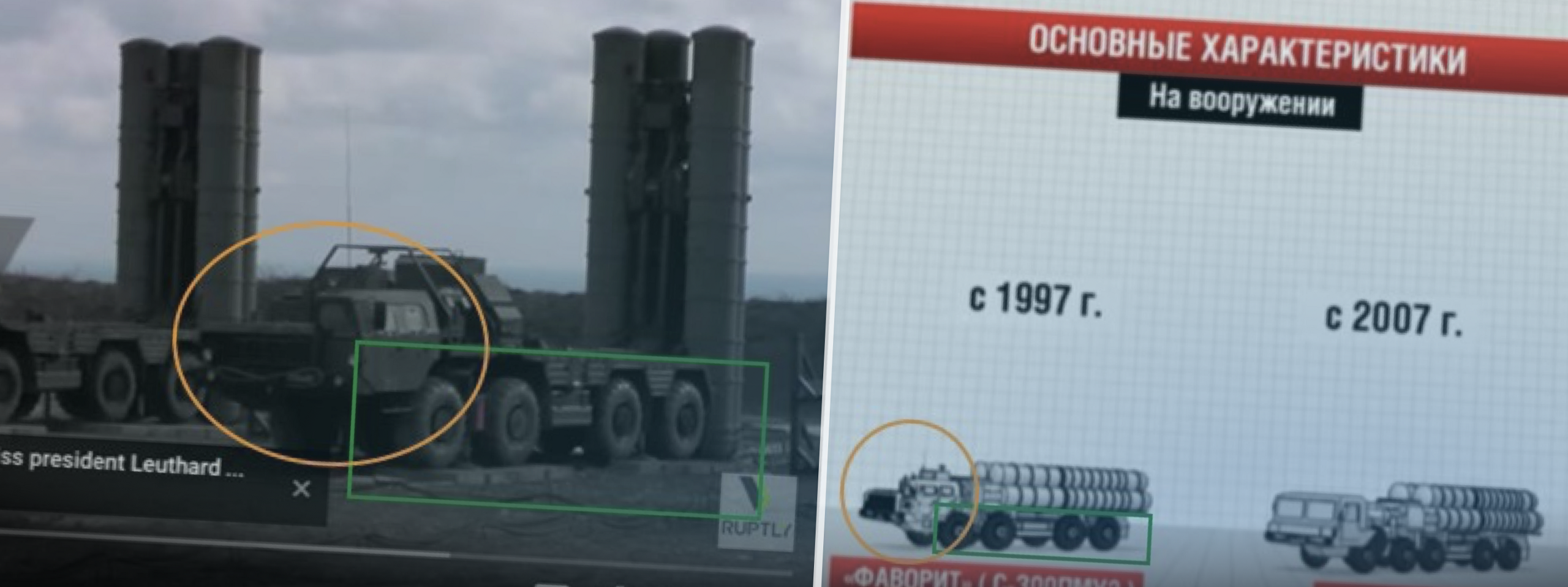New Missiles for Old?
Open source analysis of Russia’s S-400 missile claims in Crimea
New Missiles for Old?
Share this story

On January 13, RIA Novosti reported that Russia had placed its new S-400 Triumph missiles in Crimea on combat duty in Feodosia, quoting a statement from Russia’s Southern Military District. The report spread widely in Russian and English, with Kremlin broadcasters RT and Sputnik also running articles.
What can open sources tell us about the location of the missile systems, and were they genuinely S-400?
The location
News footage from 1TV Crimea about the unit provides us with a location for the deployment, with several visible features that can be geolocated:

The reporter in the video, Artyom Artyomenko, also posted photos from his visit on his Vkontakte page. We can confirm that these match the video footage.
Artyomenko geotagged his pictures to a location on the ridge south of Feodosia:

The coordinates of this point are 45.0105, 35.3981, which corresponds with other satellite and ground-level imagery showing the location of the missile deployment.
Satellite imagery for this location shows a missile facility:

Historical imagery confirms the presence of missiles on the site since at least February 2016. The S-400 missiles were reported as arriving at the base in August 2016, indicating that the launchers visible in these images are from the earlier and less capable S-300 system:

As further confirmation of the site, the unit receiving the missiles — the 18th Guards Anti-Aircraft Rocket Sevastopol-Feodosia Regiment — is, according to RT, based “near the city of Feodosia in the eastern part of the peninsula”, which matches the geolocated area.
The site is identified by multiple sources as the former base of the Ukrainian 50th Separate Anti-Aircraft Missile Regiment. Entries on Wikimapia in English and German locate former Ukrainian air-defense positions at 45.008333, 35.366944 (“Position of anti-aircraft defense rocket division”) and 45.009722, 35.398333 (“Raketenflugabwehrstellung”). The latter position is identical with that of the current Russian one.

A Russian Wikipedia entry names the Ukrainian unit as the 50th Separate Anti-Aircraft Missile Regiment. Two further sites — a military blog and an accusation of treason against the unit’s former commander by controversial Ukrainian website Mirotvorets — give the unit’s location as Cape Iliya at the eastern tip of the same peninsula, and name their weaponry as the S-300 system.

According to Reuters, this missile base was abandoned by the Ukrainian military before the Russian annexation of Crimea, and has been restored by the Russian military. The English Wikimapia entry, dated to 2012, also describes it as a ruin at that time.
However, imagery of the location from Google Earth dated to August 28, 2013, when the peninsula was still manned by Ukrainian forces, shows a missile launch facility, although its state of repair is unclear:

The weapons
Having confirmed the location of the weapon systems, it is worth examining the missiles themselves.

Russian media state that the missiles are the S-400 system. The S-400 is an updated version of the S-300 system, which has been in use since 1997.
A video comparing the S-300 and S-400 explains the differences between the systems and their transport and launch vehicles neatly.
Note that S-300 launchers are carried on a vehicle with four axles, whereas according to this visual, the S-400 launchers are carried on trailers and transporters that have five axles.
The same can be seen in two infographics produced by RIA Novosti, one for the S-300P and the other for the S-400.
These graphics also confirm that the S-400 missile launchers are carried on a trailer platform attached to a separate transport vehicle, while the S-300 launchers are mounted on the transport vehicle itself.
The image that Artyom Artyomenko shared on Vkontakte matches the visuals of the S-300 launcher, not the S-400 launcher.

Artyomenko’s photo is different from this image of an S-400 from an RT article in December 2015, which clearly shows the five-axle layout:

Artyomenko’s photos are not the only footage available from the site referring to the missiles as the S-400 system. RT also posted a video from the site referring to the anti-aircraft missiles as S-400.

Again, the imagery does not match the reported layout of the S-400 launcher, but does match the features of an S-300 launcher.
NTV has also posted a video showing similar characteristics:

The available footage is therefore consistent with launchers associated with the S-300 system, rather than the S-400. According to online sources including RIA Novosti and globalsecurity.org, the S-400 system is capable of operating with a range of launch vehicles, including those originally designed for the S-300. Lacking any view of the missiles themselves, or the supporting radar and command vehicles, the exact configuration of the system cannot be identified; however, the available imagery suggests that the newly-announced S-400 systems in Crimea are using launch vehicles from the older S-300.




